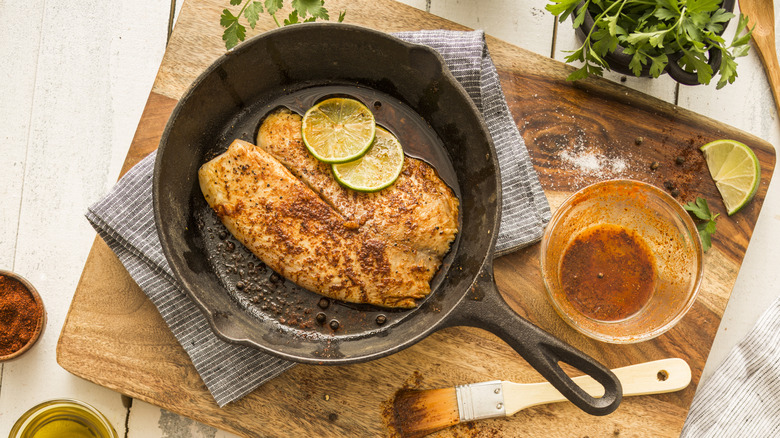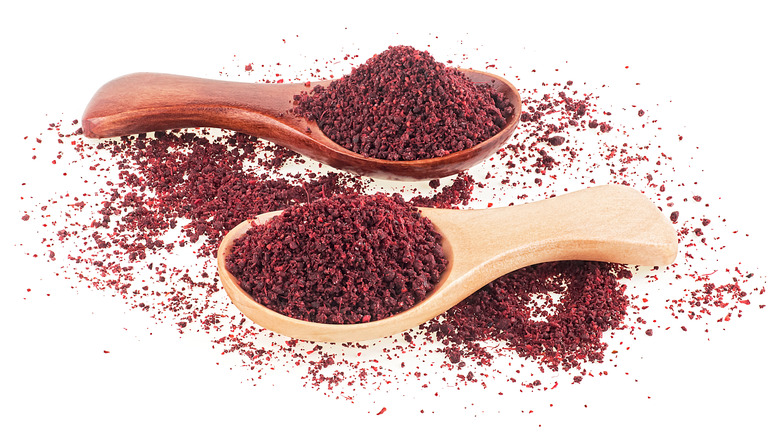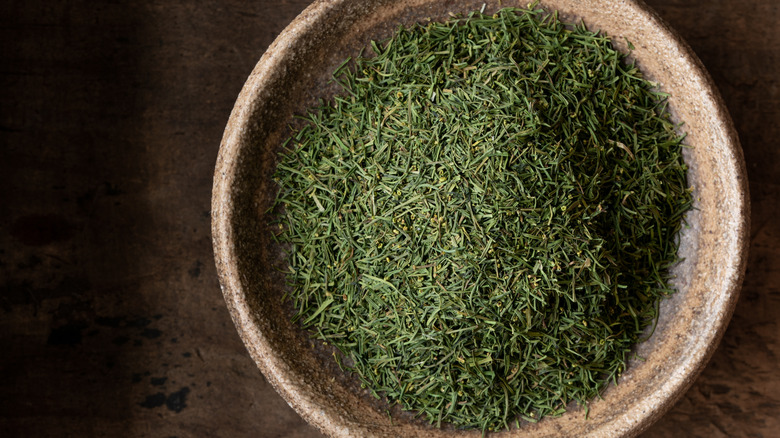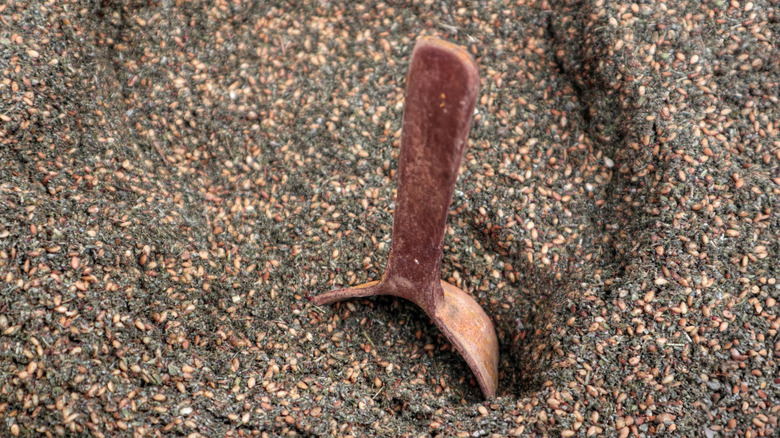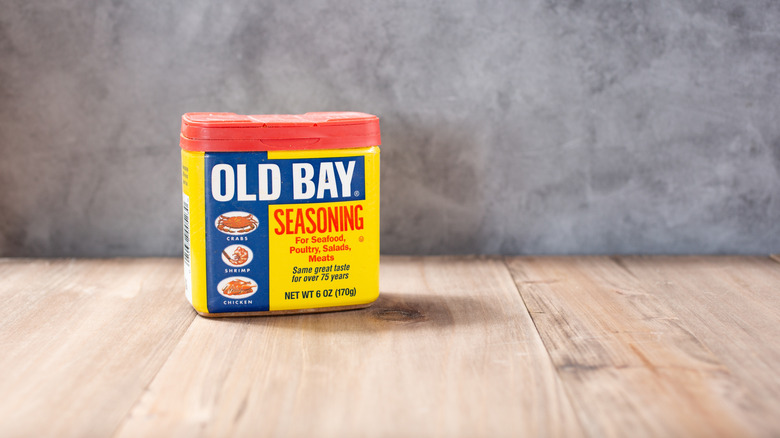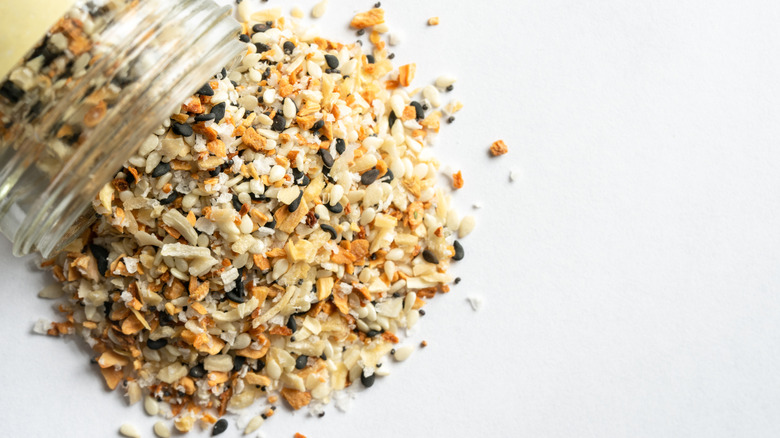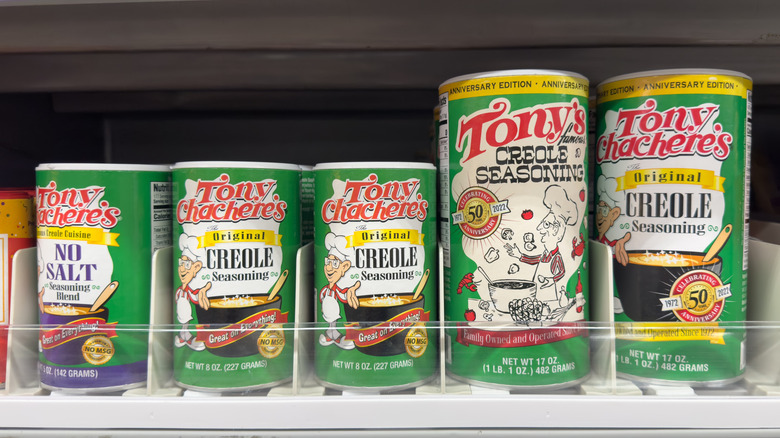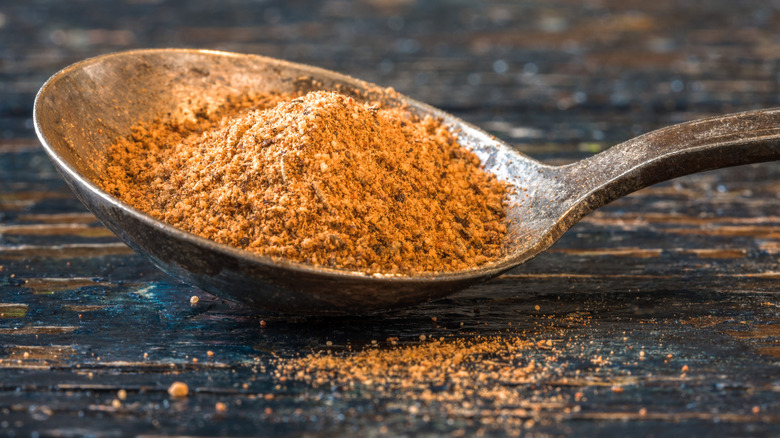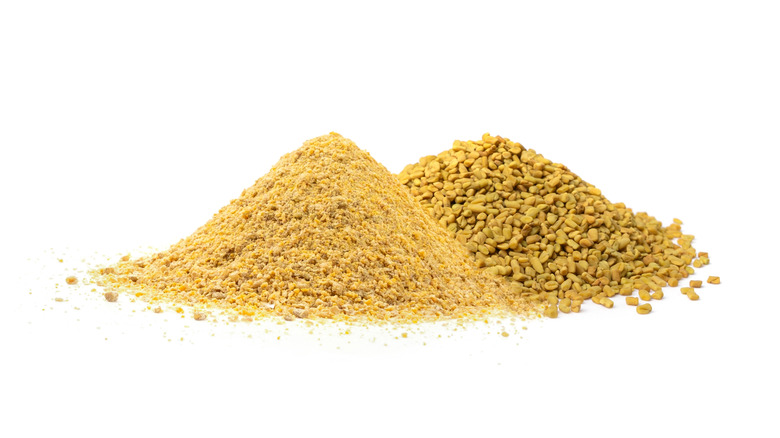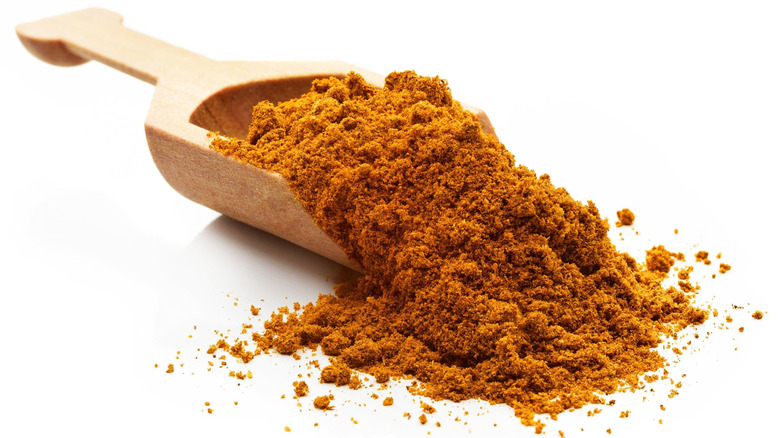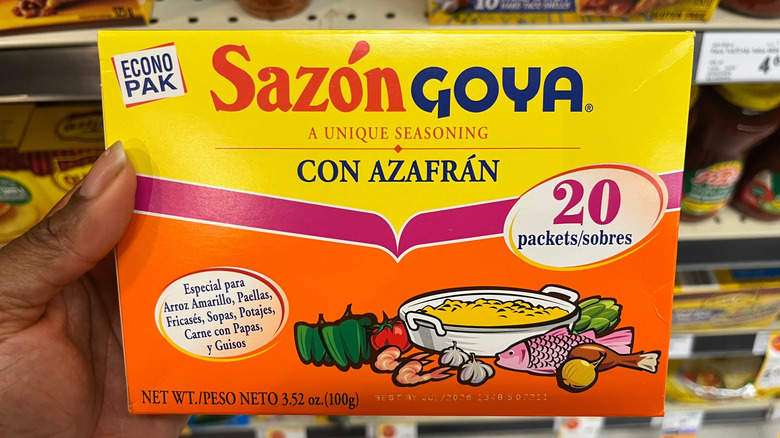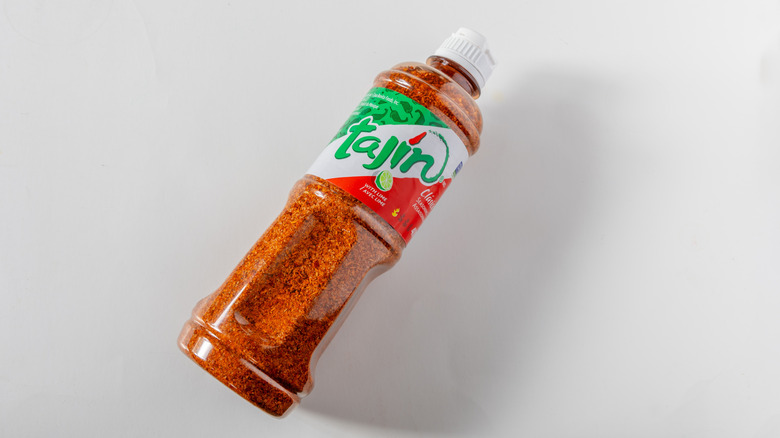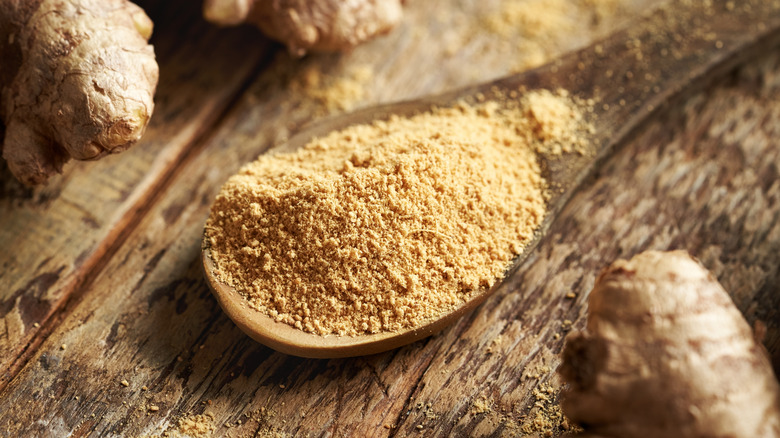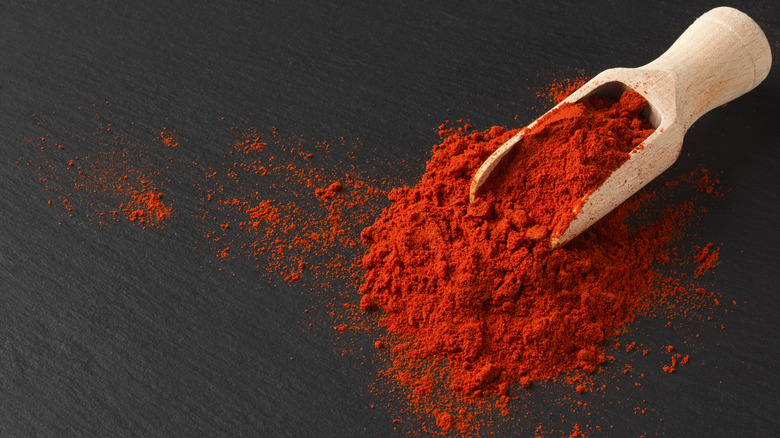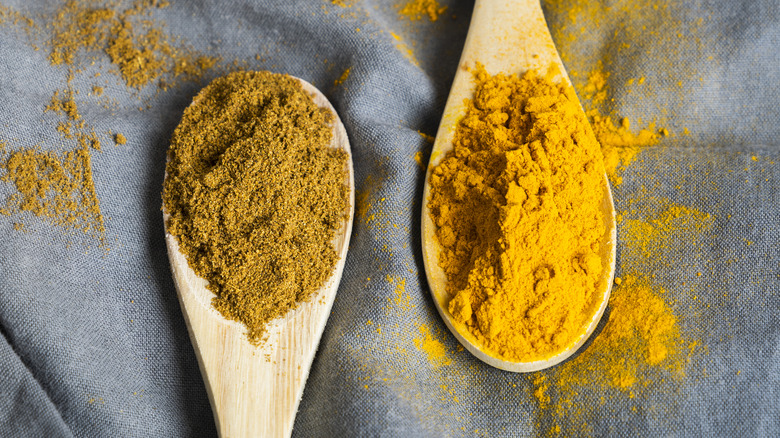Seasonings And Spices That Will Take Your Tilapia To The Next Level
We may receive a commission on purchases made from links.
According to the National Fisheries Institute's "Top 10 List For Seafood Consumption," the most recent of which focuses on data collected in 2022, tilapia is the fourth most popular fish consumed in the United States with the average annual per capita consumption standing at 1.01 pounds. Though once called the "Garbage Fish," tilapia is no longer a fish you should be avoiding. When sourced sustainably and cooked properly, it can be a fantastic option for those who prefer mildly flavored fish.
When it comes to cooking tilapia like a pro, how it is seasoned is crucial. Seasonings and spices can minimize any residual fishiness, while amplifying the slightly sweet flavor of this tender, freshwater fish. As a professional chef and culinary instructor with nearly two decades of experience, I consider myself an expert when it comes to using seasonings and spices. I enjoy tapping into my vast arsenal to create recipes that will surprise and titillate the taste buds of my guests. This is especially true when I am preparing a subtle fish like tilapia. Read on to find out the seasonings and spices I use to improve this affordable and popular seafood.
Sumac
One of my favorite spices to use on seafood in general, and on tilapia in particular, is sumac. This spice, which is well known for its presence in many Middle Eastern dishes, provides flavor notes that make it a brilliant enhancement for delicately flavored fish. It has a subtle, fruity undertone with bold citrus notes that are devoid of the astringent qualities present in lemon juice or zest.
Sumac can be purchased whole or coarsely ground, though for ease of use I recommend the latter. It has a bright, magenta hue that is visually stunning and can really liven up the milky flesh of tilapia. This spice can be sprinkled atop a tilapia filet, or it can be mixed into a marinade composed of finely minced garlic and ginger, a splash of sesame oil, and a hint of lemon juice. However, it is important to never keep tilapia in an acidic marinade for longer than 30 minutes. Otherwise, the fish's proteins will denature and it will become mushy.
Dill weed
Fish and dill is a well-known pairing. If you have ever enjoyed a classic bagel with lox, it was likely garnished with sprigs of fresh dill. While fresh dill is delightful, it is notoriously delicate and highly perishable. Dried dill weed is a fantastic alternative, especially when seasoning tilapia that is grilled, pan seared, or baked.
A good rule of thumb when using dried versus fresh dill is to use half the amount; the herb's flavor intensifies as it dries. Additionally, make sure you purchase dill weed as opposed to dill seed. The latter is too intense to be used with a delicately flavored fish like tilapia.
The primary flavors of dill weed are earthy, citrusy, and licorice-heavy. These slightly tart, savory flavors really amplify the sweet taste of cooked tilapia. This is doubly true when the dill weed is used to make a compound butter or is used as an ingredient to upgrade a homemade tartar sauce.
Za'atar
A common Middle Eastern spice blend that has been showing up on menus all over the place of late is za'atar. Za'atar is generally made from a base of dried thyme, oregano, or marjoram. These are blended with sesame seeds, sumac, and, on occasion, cumin or coriander. The precise blend tends to vary from one kitchen to another, with each chef claiming they have the best, most authentic variation.
Za'atar is particularly delicious with tilapia because of its complexity. The dried herbs provide an earthy, savory quality, the sesame a rich nuttiness, the sumac a hint of tang, the cumin a smokiness, and the coriander a peppery quality. When combined, the final flavor is extremely sophisticated and it really enhances the unassuming taste of tilapia. Because it is so multifaceted, za'atar tends to perform best when there are not a lot of other ingredients around. Simply drizzle the fish with a fruity, herbaceous, high-quality olive oil, like Ina Garten's favorite brand, Olio Santo, and coat it generously with za'atar before grilling or pan searing to achieve the best results.
Old Bay Seasoning
If you plan on frying tilapia, or any fish for that matter, the only spice blend you need for maximum flavor is Old Bay Seasoning. This versatile staple, which has been around since 1939, is made from 18 herbs and spices, including red pepper, black pepper, celery salt, and paprika.
Old Bay Seasoning, a 6 ounce container of which can be bought for under $4, is simultaneously salty and sweet and has rich umami notes that perfectly accompany virtually any kind of fish. It works particularly well with tilapia because it transforms the flesh from bland to bodacious with just a couple of shakes.
While tilapia can be fried, it does have a more fragile texture than other species that are typically cooked this way like cod or haddock. For this reason, I recommend using a basic breadcrumb coating rather than a heavy wet batter when frying tilapia. Old Bay Seasoning should be added to all three elements of the breading — flour, egg wash, and breadcrumbs — for maximum flavor.
Everything bagel seasoning
When it comes to a seasoning that belong on fish, and on tilapia in particular, you won't find many better than everything bagel seasoning. This blend, which is most commonly featured on breakfast sandwiches, features five basic components: sesame seeds, poppy seeds, garlic, dried onion, and salt.
The unique combination of aromatics, seeds, and salt provide a robust amount of flavor that has nutty, savory, and earthy notes. These flavors pair perfectly with tilapia when the seasoning is sprinkled directly onto the fish or is added to its breading. As the seeds have a tendency to crisp up when cooked, this seasoning provides a textural component that beautifully contrasts with the tender flesh of tilapia.
One key thing to keep in mind when using everything bagel seasoning is that the seeds can burn if they are exposed to high temperatures. For this reason, I recommend cooking this fish at a lower temperature or using a French method known as "en papillote" which involves wrapping the fish in parchment paper or foil prior to cooking. This protective layer will prevent the seeds from scorching and will ensure that the cooked tilapia is incredibly moist.
Cajun seasoning
One of the great culinary traditions of the South is Cajun food. Although Cajun food is not a monolith, there are some characteristic features that make Cajun seasoning fantastic for using on tilapia. Most variations are packed with cayenne pepper, black pepper, and garlic. This gives the spice blend an enticing mixture of subtle aromatics and a bold spiciness that, while potent, does not completely desensitize your tongue.
When using Cajun seasoning on tilapia, it is a good idea to practice some restraint. A little goes a long way, and you do not want to mask the inherently sweet flavor of the fish. Additionally, if you really want to pay homage to Cajun cuisine, adding a little pork to the mix is always a good idea. Try stewing the tilapia and Cajun seasoning together with some chorizo and the holy trinity of Cajun cooking: onions, peppers, and celery. Or, simply add the tilapia and some Cajun seasoning to your favorite gumbo recipe for a change of pace.
Creole seasoning
Even though they are somewhat different, Creole and Cajun cuisines are often conflated. Creole cuisine is often considered the bougie culinary tradition of the bayou, and this style of cooking and seasoning tends to favor more elevated recipes. Creole seasoning, though similar to Cajun seasoning thanks to its use of black pepper, garlic powder, onion powder, and cayenne pepper, typically leans more towards herbaceous elements. It often contains oregano, thyme, and rosemary. A dash of paprika is also thrown in for color and a piquant flavor. In this sense, Creole seasoning is perhaps an even more well-rounded choice for tilapia in that it adds in some grassy, even smoky elements alongside the spicy, salty, and savory ones.
When using Creole seasoning with tilapia, again, it pays to be discerning; you do not want to overwhelm the fish. I recommend starting with a less spicy iteration of Creole seasoning, like Tony Chachere's Original Creole Seasoning, and coating the fish lightly. The resulting tilapia would work really well in fish tacos. It would also be delightful in a twist on a classic étouffée.
Jerk seasoning
If you love heat, classic jerk seasoning is exactly what you need for your tilapia. This seasoning, which originated in Jamaica, but is popular throughout the Caribbean, was historically created to season meat that was slow smoked. While its uses and the precise ingredients have expanded and evolved, it still packs a punch.
Most blends contain a combination of onion, garlic, salt, sugar, thyme, chives, allspice, and chili peppers, among other spices. The allspice and chili peppers are what really give jerk seasoning its distinctive sweet and hot flavor. The level of heat from one blend to the next may vary depending on what variety of chilis are used, but remember, this is intended to be a hot spice blend. To help tame the heat just slightly, and prevent it from overpowering the tilapia, this seasoning works best as a marinade. Combine it with oil, honey, citrus juice, and fresh herbs, and allow the tilapia to marinate in this mixture for 15 to 30 minutes before grilling or baking it. The end result is an incredibly flavorful dish.
Ground fenugreek
A spice that many may recognize when they taste it, but probably don't know much about, is fenugreek. This spice, which works extremely well with tilapia, is most typically associated with Indian and North African cuisines. (That being said, it is often a key ingredient in quality Italian sausages.) Fenugreek has a flavor that is bittersweet and tastes almost like caramel. It also has a phenomenal aroma that can really level up mild-flavored fish, including tilapia.
I typically purchase ground fenugreek, though you can also obtain whole seeds. I often blend it with sweeter spices, like cinnamon or cardamom to help tame some of its more astringent flavors before adding it to tilapia. This has the added benefit of creating a final dish with many layers of flavor. For example, you can coat tilapia with a combination of fenugreek, cinnamon, and turmeric to create a fish dish that tastes similar to some Indian curries.
Ras el hanout
One of the first things I ate upon landing in Morocco was a delicate white fish seasoned with a spice blend called ras el hanout. Ever since, the flavor has been etched into my memory and taste buds. For this reason, I cannot recommend combining tilapia with ras el hanout enough.
Ras el hanout is a North African seasoning that contains up to 40 different spices. Its name translates to "top shelf," an indicator that this blend contains a proprietary combination of spices that represent the highest quality available. Every home and spice shop has its own blend. That said, there are some commonalities that make it particularly suited to using on tilapia.
The complex seasoning has a robust sweet and savory flavor that is often dominated by cinnamon, cumin, turmeric, and paprika. One product that I have been using for years is a blend from Zamouri Spices which also features fragrant lavender, fruity rose buds, and spicy monk's pepper. This aromatic, potent, and sophisticated blend is all you need to produce a seared, grilled, or baked tilapia that is immensely flavorful. Just coat the fish in ras el hanout, revel in the wonderful fragrances that are released during cooking, and enjoy the dish's kaleidoscopic range of flavors when it is ready.
Sazón
Another spice blend that has sentimental value to me, and that can completely revolutionize a tilapia filet, is Sazón. Sazón is a seasoning blend that I was introduced to by a Southern chef of Puerto Rican origin. It is often featured in the culinary traditions of Latin Americans from across Central and South America.
The seasoning is a colorful and flavorful assembly of spices that is punctuated by the presence of annatto seed powder. This spice gives whatever you cook with the blend a stunning crimson hue. Other ingredients that generally feature in Sazón include cumin, garlic powder, oregano, and black pepper.
One of the most popular versions of Sazón that's available in the United States is from the Goya brand. This brand produces many different versions of the spice, but it's the saffron-flavored version that is a particularly suited to using with tilapia. The delicate, floral saffron lends a nice juxtaposition to the seasoning's other earthy, rich flavors. When combined, this mixture beautifully complements the sweet tilapia flesh. Again, simplicity is key. A drizzle of olive oil and a liberal coating of Sazón is all that you need to make this fish shine.
Tajín Seasoning
When it comes to spice blends that pack a punch, few are as pronounced or versatile as Tajín Seasoning. Tajín Seasoning is really a powerhouse that you can put on everything, including tilapia. Tajín Seasoning contains a variety of ingredients, including mild chili peppers, lime, and salt. It has a refreshing, slightly spicy, savory flavor that is especially well suited to fish.
There are a couple of great ways to use Tajín Seasoning to flavor tilapia. One is to use it to season tilapia ceviche; the lime in the spice blend works well with the acidity that's used to cure the tilapia. Another way is to add Tajín Seasoning to a fruit salsa that's served alongside tilapia. This spice blend is frequently sprinkled atop fruit. It helps to amplify the fruits' sweetness while contributing acidic notes that pair beautifully with the mild-tasting tilapia.
Ground ginger
There's a reason that ground ginger is featured prominently in the culinary traditions of cultures across the globe, including Southeast Asian and Caribbean cuisines. Its unique, earthy, spicy, yet slightly sweet taste lends itself to dishes featuring mild-flavored fish like tilapia.
This rhizome, which is related to cardamom and turmeric, is often used fresh. That said, fresh ginger is highly perishable and can be hard to work with. Ground ginger is easier to use and more potent. Because of this, when adding ground ginger to tilapia recipes, it is important not to overdo it. After all, this is a spice that can quickly dominate an entire dish, turning up the heat and lending a notable bitterness.
One great way to prevent ground ginger from dominating tilapia is to combine the spice with garlic, fresh cilantro, lime juice, sesame oil, soy sauce, and a hint of honey for a quick, Asian-inspired marinade. This will boost the bland fish's flavor without making the flesh taste bitter.
Smoked paprika
Paprika may seem like a relatively simple ingredient; it is often used as a garnish for deviled eggs and dips, but it is far more nuanced than these applications suggest. Having grown up in a Hungarian household that relied on premium Menol Spices Authentic Hungarian Smoked Paprika Powder to amp up the flavor of everything from a classic chicken paprikash to a braised fish stew, I can attest that this is a versatile spice that absolutely belongs on tilapia.
For the uninitiated, paprika is more than just a colorful spice. This mixture of dried peppers can have a number of different flavors, ranging from mild to hot and sweet to smoked. Smoked paprika, in particular, is intensely flavorful, with a richness that is fantastic at enhancing the taste of mild ingredients, including tilapia.
To get the best out of this pairing, sprinkle paprika directly onto the tilapia filet and smoke it. This will create a surprisingly moist and delicious piece of fish that is sure to make your mouth water. Whether you use Hungarian, Spanish, or any other variety of smoked paprika, make sure that it is fresh. Paprika that is past its prime will tend to lose its luster and turn a dull, brownish hue. It also becomes somewhat rancid tasting and has a tinny aftertaste that is unappetizing.
Curry powder
If you want to cook tilapia using the trick that Gordon Ramsay uses to make flavorful fish and chips, look no further than the jar of curry powder that's sitting in your pantry. Contrary to popular belief, curry powders are not all the same; the blend of spices can vary from product to product. While many contain the same basic elements, including coriander, fenugreek, turmeric, and cumin, these are by no means the only spices that can make their way into curry powder.
One of my favorite products to use with tilapia is the Rani Curry Powder Mild Blend. Though every bit as tasty as hotter varieties, this one blend is slightly less pungent and has a nice sweet and savory combination. This means it adds a lot of flavor to the tilapia without overpowering it. When used as a seasoning to flavor the fish, this curry powder not only adds a great deal of complex flavor, it also gives the fish a gorgeous yellow color.
